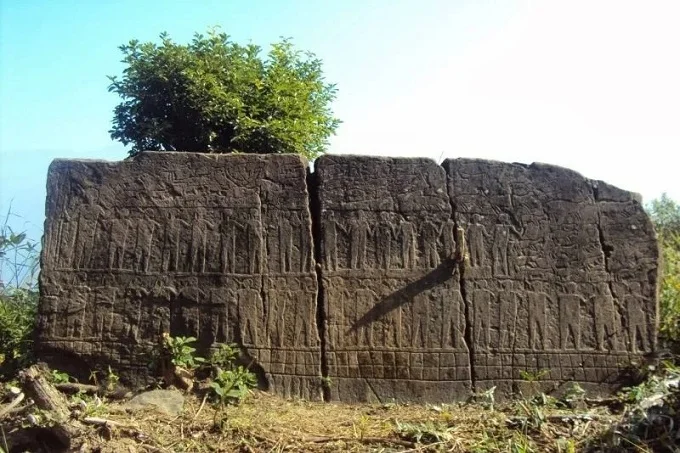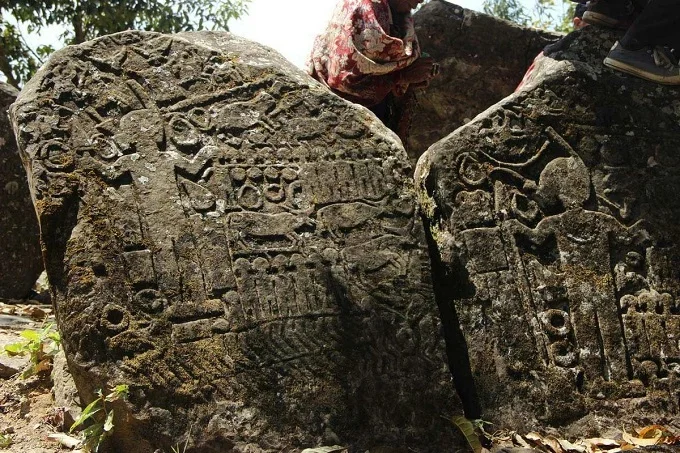Are the megaliths of Mizoram the remains of an unknown ancient civilization?

At one of the archaeological sites in India, there are hundreds of megalithic stones with drawings carved on them. The drawings depict people, animals, flowers, geometric ornaments.
Once upon a time, there were more than six hundred megaliths in the small village of Vangchhia, in the Indian northeastern state of Mizoram. The elders remember playing among them as a child, not knowing where they came from and why they were located here.
For hundreds of years, the inhabitants of the settlement destroyed megalithic monuments and used them for their own needs, for lining the walls of grave pits to deceased members of the community.

Megaliths in Vangchhia were not a new discovery for 82-year-old P. Romingthang, who has been managing the branch of the Indian National Foundation for Art and Cultural Heritage (INTACH) in Mizoram since 2009.
According to him, he caught a glimpse of Vangchhia in 1973, when he was making a helicopter tour as an employee of the Indian administrative service. He said that he saw the top of the hill without any forest cover and massive stones erected. There was no road to Vangchhia for motor transport at that time, and it was possible to get to the village only on foot.
Romingthanga left Mizoram in 1976. Although he returned in the late 1980s as Chief Secretary, his planned trips to Vangchhia were repeatedly postponed due to insurgency in the area or road repairs. Decades later, he decided to continue his interest in the Mizo culture.

In the summer of 2010, Romingthanga finally saw what he often thought about. By th at time, the village of Vangchhia had been keeping menhirs for many years, at the direction of the local branch of the Mizo Association, the largest voluntary organization of Mizoram, and named this place “Kawtchhuah Ropui” (“Great Gate”).
When P. Romingthanga and the INTACH team visited this facility for the first time, they were amazed and dejected at the same time. “I was told that initially there could have been at least 600 megaliths in this place compared to the current 200 or so that still exist. This is a place that needs to be protected and preserved… and that needs to be brought to the attention of not only the rest of India, but the whole world,” Romingthanga said.
But menhirs with mysterious drawings are not unique to Vangchhia. Clusters of menhirs, though with a smaller number, are scattered along the eastern Mizoram mountain range in areas near the villages of Farkawn, Lianpui, Khankawn, Khawbung, and Dungtlang.
Scientific research
A group of archaeologists began excavating the mysterious megalithic structures in Vangchhia in 2015. Sujit Nayan, assistant Chief Archaeologist at ASI Delhi and head of excavations at Vangchhia, said that this is one of the most important archaeological finds of our time. He added that this place is the key to hitherto unknown facts about Mizoram and the country’s northeast.

“We explored what is hidden under the bushes and dense foliage. This site may contain traces of a lost city or a greater lost civilization. It’s amazing to come across so many artifacts. We need more time and research to come to a final conclusion,” Nayan said.
Fragments of charcoal and pottery were sent to laboratories for radiocarbon dating and other scientific analyses. But the results have not yet been made public.
More questions than answers
How old are these monoliths? Who cut them out and how? The people of the Mizo culture did not know iron until India came under the influence of England around 1757. What do the drawings mean? Where were these huge stones mined if there were no known quarries nearby, except for riverbeds located several kilometers away and far below the steep cliffs? The question also arises, how were they transported? Many of them are very large. The largest of the stones has a height of 4.5 meters.
After the excavations of this area began, the remains of urban architecture were found here: more than ten different terraces, a wide street, a series of artificial caves, a watchtower, pavilions, retaining walls, stairs, embankments, and a necropolis. The research has not yet been completed.




